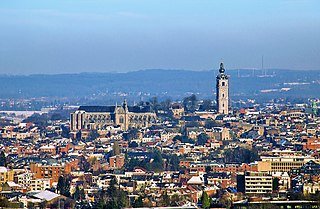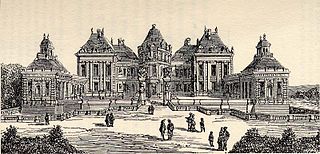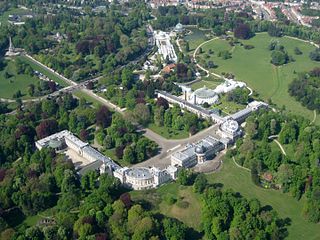Related Research Articles

Mons is a city and municipality of Wallonia, and the capital of the province of Hainaut, Belgium.

The French National Museum of Natural History, known in French as the Muséum national d'histoire naturelle, is the national natural history museum of France and a grand établissement of higher education part of Sorbonne Universities. The main museum, with four galleries, is located in Paris, France, within the Jardin des Plantes on the left bank of the River Seine. It was formally founded in 1793 during the French Revolution, but was begun even earlier in 1635 as the royal garden of medicinal plants. The museum now has 14 sites throughout France.

Brussels Park is the largest urban public park in central Brussels, Belgium. Formerly known and still sometimes colloquially referred to as the Royal Park, it was also the city's first public park. The area of the rectangular park is 13.1 ha.

The Castle of Freÿr with its gardens in the style of Le Nôtre is located in Wallonia on the left bank of the Meuse, between Waulsort and Dinant. They form one of the most magnificent natural sites in Belgium. It has been classified as one of Wallonia's major heritage sites. It is often called a greatly reduced Versailles. Originally a Renaissance castle, it was extended in the 18th century and was once the residence of dukes and their royal guests. It has gardens including orange trees. The more than three-hundred-year-old orangeries are the oldest in the Low Countries.

The Château de Saint-Cloud was a château in France, built on a site overlooking the Seine at Saint-Cloud in Hauts-de-Seine, about 5 kilometres west of Paris. On the site of the former palace is the state-owned Parc de Saint-Cloud.

The Château du Raincy was constructed between 1643 and 1650 by Jacques Bordier, intendant des finances, on the site of a Benedictine priory on the road from Paris to Meaux, in the present-day commune of Le Raincy in the Seine-Saint-Denis department of France.

The Palace of Laeken or Castle of Laeken is the official residence of the King of the Belgians and the Belgian Royal Family. It lies in the Brussels-Capital Region, 5 km (3 mi) north of the city centre, in Laeken, and sits in a large private park called the Royal Domain of Laeken.

The Royal Greenhouses of Laeken are a vast complex of monumental heated greenhouses in the park of the Royal Palace of Laeken, Belgium. The historic complex contains tropical, subtropical and cold greenhouses.

Alphonse Hubert François Balat was a Belgian architect.

Mariemont, also Morlanwelz-Mariemont, is a former royal estate and hunting park in Belgium, created in the 16th century by Mary of Hungary, from whom it took its name. It was reconstructed several times through the centuries before being finally destroyed in 1794.

Tilman-François Suys or Tieleman Frans Suys was a Belgian architect who also worked in the Netherlands.

The Hôtel de Sully is a Louis XIII style hôtel particulier, or private mansion, located at 62 rue Saint-Antoine in the Marais, IV arrondissement, Paris, France. Built at the beginning of the 17th century, it is nowadays the seat of the Centre des Monuments Nationaux, the French national organization responsible for national heritage sites. It has been listed since 1862 as a monument historique by the French Ministry of Culture.

The Botanical Garden of Brussels is a former botanical garden in Brussels, Belgium. It was created in 1826 and stood on the Rue Royale/Koningsstraat in Saint-Josse-ten-Noode, near Brussels' Northern Quarter financial district, until its relocation in 1938 to the National Botanic Garden of Belgium in Meise, Flemish Brabant.

Ny is a village of Wallonia in the municipality and district of Hotton, located in the province of Luxembourg, Belgium.

Val-Saint-Lambert Abbey was a Cistercian abbey in the Prince-Bishopric of Liège. It is situated in Wallonia in the city of Seraing on the right bank of the Meuse, in Belgium, about 13 kilometres (8.1 mi) southwest of Liege. Founded in 1202, the abbey's monks were expelled during the French Revolution. In the 19th century, the building ruins were converted into the Val Saint Lambert crystal factory. The structure is considered to be an important example of Cistercian architecture.

Neoclassical architecture appeared in Belgium during the period of Austrian occupation in the mid-18th century and enjoyed considerable longevity in the country, surviving through periods of French and Dutch occupation, and the birth of Independent Belgium, surviving well into the 20th century.

The Florennes Castle in Florennes, Namur, Wallonia, Belgium, is a castle that dates back to the 9th century, although the most of the modern structure is much more recent.

The Château de Fontaine is a chateau in the municipality of Onhaye, Wallonia in the Belgian province of Namur. It is located south of the village of Anthée.

The Château de Châteauneuf-sur-Loire is a French castle, built in the 17th and 18th centuries, located in Châteauneuf-sur-Loire in the department of Loiret in the Centre-Val de Loire region.

The park known today as Les Orangeries of Bierbais is located in Hévillers, a section of the municipality of Mont-Saint-Guibert, located in the Wallonia in the province of Walloon Brabant in Belgium.
References
- ↑ Nathalie De Harlez De Deulin, « Les jardins du château de Freÿr. Etude historique et documentaire », in Freÿr-sur-Meuse. Un patrimoine exceptionnel en province de Namur, éd. Jacques Toussaint, 2013, p. 676. ISBN 9782875020420
- ↑ Archive publique de la province de Brabant, Arrondissement de Nivelles
- ↑ Service public de Wallonie (2010). Court-Saint-Étienne, Mont-Saint-Guibert et Ottignies - Louvain-la-Neuve. Patrimoine architectural et territoires de Wallonie. Vol. 16. Catherine Dhem et Geneviève Rulens. p. 116. ISBN 9782804700652.
- (nl) Xavier Duquenne, « Drie Duitse tuinarchitecten (Charles-Henri Petersen 1792-1859, Louis Fuchs 1818-1904, Édouard Keilig 1827-1895) », in Historische woonsteden & tuinen, 2008, No. 1, pp. 19–22.